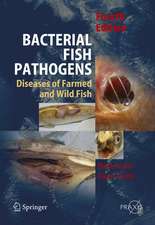Epithelial Organization and Development
Editat de T.P. Flemingen Limba Engleză Hardback – 30 sep 1992
| Toate formatele și edițiile | Preț | Express |
|---|---|---|
| Paperback (1) | 1222.01 lei 43-57 zile | |
| SPRINGER NETHERLANDS – 3 oct 2012 | 1222.01 lei 43-57 zile | |
| Hardback (1) | 1228.15 lei 43-57 zile | |
| SPRINGER NETHERLANDS – 30 sep 1992 | 1228.15 lei 43-57 zile |
Preț: 1228.15 lei
Preț vechi: 1497.75 lei
-18% Nou
Puncte Express: 1842
Preț estimativ în valută:
235.01€ • 245.99$ • 195.60£
235.01€ • 245.99$ • 195.60£
Carte tipărită la comandă
Livrare economică 31 martie-14 aprilie
Preluare comenzi: 021 569.72.76
Specificații
ISBN-13: 9780412398902
ISBN-10: 0412398907
Pagini: 385
Ilustrații: XVII, 385 p.
Dimensiuni: 155 x 235 x 24 mm
Greutate: 0.74 kg
Ediția:1992
Editura: SPRINGER NETHERLANDS
Colecția Springer
Locul publicării:Dordrecht, Netherlands
ISBN-10: 0412398907
Pagini: 385
Ilustrații: XVII, 385 p.
Dimensiuni: 155 x 235 x 24 mm
Greutate: 0.74 kg
Ediția:1992
Editura: SPRINGER NETHERLANDS
Colecția Springer
Locul publicării:Dordrecht, Netherlands
Public țintă
ResearchCuprins
1 Intercellular junctions and cell adhesion in epithelial cells.- 1.1 Introduction.- 1.2 Desmosomes.- 1.3 Adherens junctions.- 1.4 Cell-cell adhesion molecules.- 1.5 Tight junctions.- 1.6 Gap junctions.- 1.7 Conclusion.- Acknowledgements.- References.- 2 Shaping an epithelial cell: the role of cell adhesion molecules in the reorganization of the membrane cytoskeleton.- 2.1 How can polarity develop de novo?.- 2.2 MDCK cells as an experimental system.- 2.3 Determining the underlying mechanisms.- 2.4 Back to MDCK cells.- 2.5 The role of uvomorulin in the establishment of polarity.- 2.6 Cell-cell contacts and other cytoskeletal proteins.- 2.7 Cell contacts and the formation of intercellular junctions.- 2.8 The development of epithelial polarity in MDCK cells.- 2.9 Cell adhesion molecules and regulation of the development of cell surface polarity.- 2.10 Extending the in vitro model to in vivo situations.- 2.11 Conclusion.- Acknowledgements.- References.- 3 Biogenetic pathways and targeting signals in polarized epithelia.- 3.1 Organization of polarized epithelia.- 3.2 Development of polarity.- 3.3 Biogenetic pathways of apical and basolateral proteins.- 3.4 Signals.- 3.5 Cytoskeleton.- 3.6 Conclusions and future directions.- References.- 4 Trophectoderm biogenesis in the preimplantation mouse embryo.- 4.1 Introduction.- 4.2 Early cell cycles: programming for an epithelium.- 4.3 Compaction: the foundation of epithelial organization.- 4.4 Morula and blastocyst: preparation for epithelial function.- 4.5 Conclusions.- Acknowledgements.- References.- 5 The formation and fate of the blastoderm epithelium of the Drosophila embryo.- 5.1 Introduction.- 5.2 Pre-blastoderm cortex organization.- 5.3 The formation of the syncytial blastoderm.- 5.4 The cellularization switch.- 5.5 Conclusion.- Acknowledgements.- References.- 6 Development of kidney epithelial cells.- 6.1 Introduction.- 6.2 Morphological characterization of in vivo and in vitro development of epithelial kidney tubules.- 6.3 Search for inducers.- 6.4 Response to induction.- 6.5 Conclusions.- References.- 7 Development of the insect Malpighian tubule.- 7.1 Introduction.- 7.2 Early development: establishing an epithelium.- 7.3 Later development: cell differentiation within the epithelium.- 7.4 Interdependence of developmental processes.- 7.5 Outlook.- Acknowledgements.- References.- 8 The establishment and maintenance of hepatocyte surface polarity.- 8.1 Introduction.- 8.2 The hepatocyte in liver tissue.- 8.3 Hepatocyte surface polarity.- 8.4 Sorting pathways for integral plasma membrane proteins in hepatocytes.- 8.5 Hepatocytes in culture.- 8.6 The hepatocyte in embryonic development.- 8.7 Proliferation of hepatocytes.- 8.8 Hepatocytic stem cells.- Acknowledgements.- References.- 9 Cytoskeletal components in intestinal brush border morphogenesis: an evaluation of their function.- 9.1 Introduction.- 9.2 Organization of intestinal brush border cytoskeleton.- 9.3 Brush border assembly during intestinal epithelial cell differentiation.- 9.4 Structural properties of the brush border cytoskeletal proteins.- 9.5 Approaches to investigate brush border assembly.- 9.6 Conclusion.- Acknowledgements.- References.- 10 The role of yolk sac and gut epithelial cells in maternal immunoglobulin transport.- 10.1 Introduction.- 10.2 Evidence for Fc receptors on yolk sac endoderm and gut enterocytes.- 10.3 Nature of the Fc?Rs.- 10.4 Mechanism of transcytosis of IgG.- 10.5 Conclusions.- Acknowledgements.- References.- 11 Cell adhesion and the basement membrane in early epidermal morphogenesis.- 11.1Morphogenesis of the epidermis.- 11.2 Integrin expression and function in the epidermis.- 11.3 Pathological disorders in cell adhesion in the skin.- 11.4 Summary and discussion.- References.- 12 Functional interplay between extracellular matrix and extracellular matrix-degrading proteinases in the mammary gland: a coordinate system for regulating mammary epithelial function.- 12.1 Introduction.- 12.2 Effect of extracellular matrix on epithelial cell function in culture.- 12.3 The mammary gland: a model to study cell-extracellular matrix interaction in vivo.- 12.4 Extracellular matrix-degrading proteinases are involved in mammary development.- 12.5 Conclusion.- Acknowledgements.- References.- 13 Salivary epithelium branching morphogenesis.- 13.1 Introduction.- 13.2 Motive forces and epithelial morphogenesis.- 13.3 Tissue interactions in branching morphogenesis.- 13.4 The extracellular matrix as a regulator of epithelial morphogenesis.- 13.5 Conclusions.- Acknowledgements.- References.
Recenzii
This text will be a valuable reference for students and research workers - Biological Abstracts; ...very up-to-date. Myriads of references...Tom Fleming has done an excellent job. He seems to have chosen all the right people, briefed them thoroughly on what he wanted and, as a result, has produced a volume which, although diverse in authorship, is remarkably consistent...I don't think it will age as fast as some similar volumes because of the quality of reviews and because of their comprehensive nature. Well done, Tom and Chapman and Hall - British Society for Cell Biology Newsletter; Tom Fleming has assembled a group of 13 articles, many from highly respected groups, that probe diverse topics ranging from details of epithelial structure of the development of a variety of epithelial tissues. The result is a wide-ranging and unique perspective (giving a full picture of how epithelial tissues are formed and how they work)... - Trends in Cell Biology









